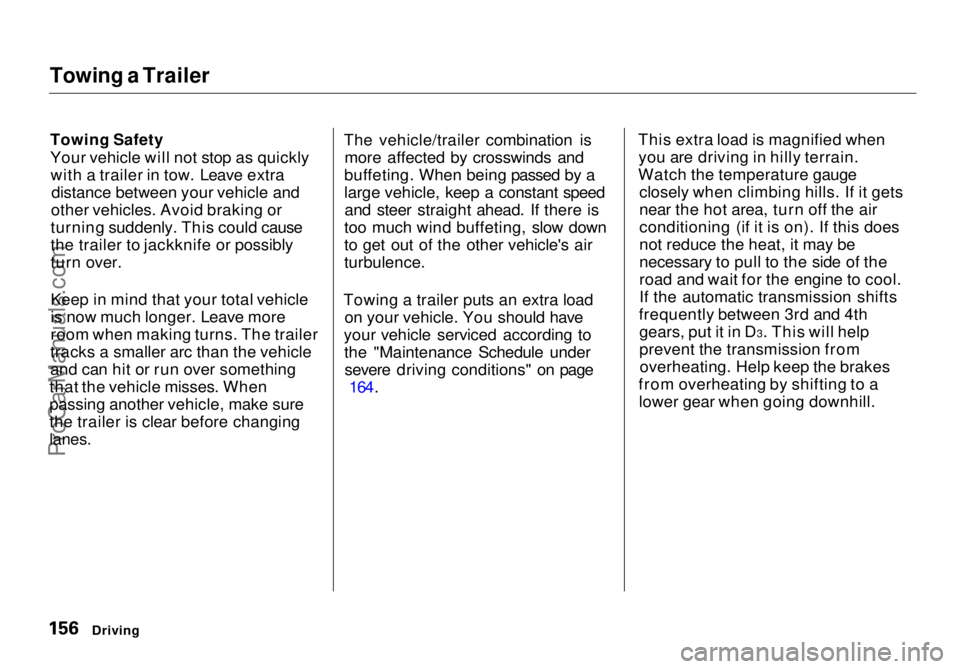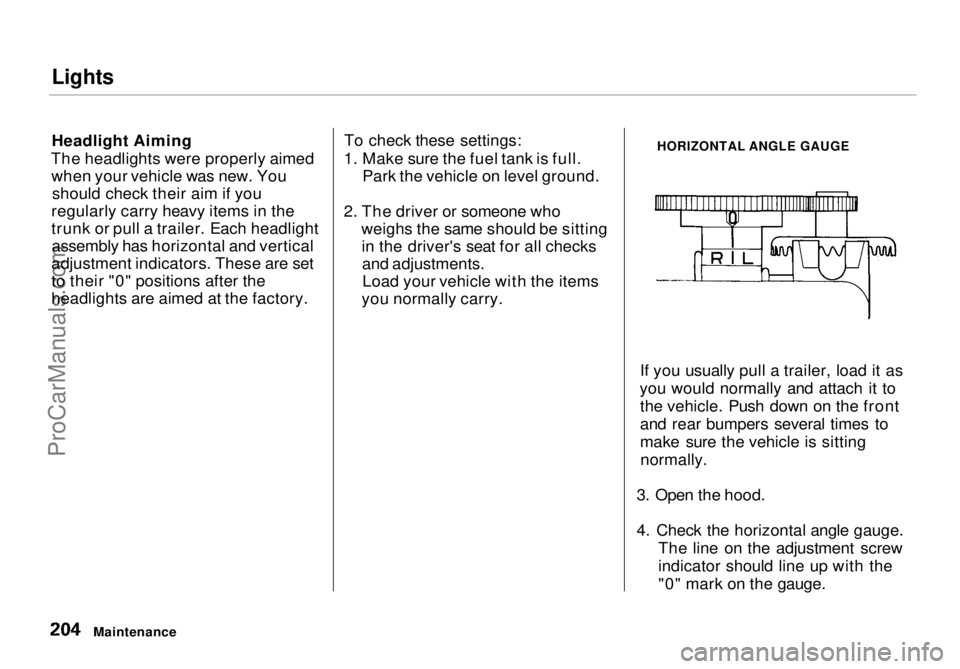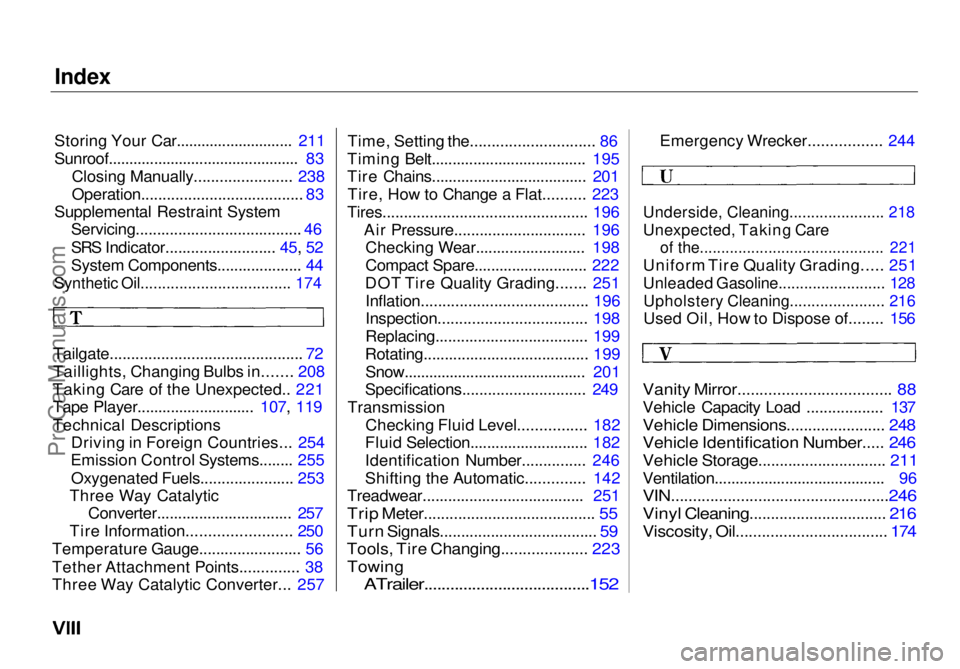Page 156 of 272

Towing a Trailer
Towing Safety
Your vehicle will not stop as quicklywith a trailer in tow. Leave extra distance between your vehicle and
other vehicles. Avoid braking or
turning suddenly. This could cause
the trailer to jackknife or possibly
turn over.
Keep in mind that your total vehicle
is now much longer. Leave more
room when making turns. The trailer
tracks a smaller arc than the vehicle
and can hit or run over something
that the vehicle misses. When
passing another vehicle, make sure
the trailer is clear before changing
lanes.
The vehicle/trailer combination is
more affected by crosswinds and
buffeting. When being passed by a
large vehicle, keep a constant speed and steer straight ahead. If there is
too much wind buffeting, slow down
to get out of the other vehicle's air
turbulence.
Towing a trailer puts an extra load on your vehicle. You should have
your vehicle serviced according to the "Maintenance Schedule undersevere driving conditions" on page 164. This extra load is magnified when
you are driving in hilly terrain.
Watch the temperature gauge closely when climbing hills. If it gets
near the hot area, turn off the air
conditioning (if it is on). If this does
not reduce the heat, it may be
necessary to pull to the side of the
road and wait for the engine to cool.
If the automatic transmission shifts
frequently between 3rd and 4th gears, put it in D3. This will help
prevent the transmission fromoverheating. Help keep the brakes
from overheating by shifting to a lower gear when going downhill.
DrivingProCarManuals.comMain Menu Table of Contents s t
Page 157 of 272
Towing a Trailer
If you have to stop while going uphill,
do not hold the vehicle in place by
pressing on the accelerator. This can cause the automatic transmission tooverheat. Use the parking brake or
footbrake.
When parking your vehicle and trailer, especially on a hill, be sure to
follow all the normal precautions.
Turn your front wheels into the curb, set the parking brake firmly, and put
the transmission in Park. In addition,
place wheel chocks at each of the
trailer's tires. Backing up with a trailer is difficult
and takes practice. Drive slowly,
make small movements with the steering wheel, and have someonestand outside to guide you. Grip the
steering wheel on the bottom (rather
than the usual position near the top). Move your hand to the left to get the
trailer to move to the left, and right
to move the trailer right.
DrivingProCarManuals.comMain Menu Table of Contents s t
Page 165 of 272
Maintenance Schedule (Severe Conditions)
Follow the Severe Conditions
Maintenance Schedule if youdrive your vehicle MAINLY
under one or more of the
following conditions:
Driving less than 5 miles (8
km) per trip or, in freezing temperatures, driving less
than 10 miles (16 km) per trip. Driving in extremely hot
[over 90°F (32° C)] conditions. Extensive idling or long
periods of stop-and-go driving.
Trailer towing, driving with a roof top carrier, or driving in
mountainous conditions. Driving on muddy, dusty, or
de-iced roads.
For Canadian Owners
Follow the Maintenance
Schedule for Severe Conditions.
* 1: Refer to page 195 for replacement
information under special driving
conditions.
MaintenanceProCarManuals.comMain Menu Table of Contents s t
Page 166 of 272
Maintenance Schedule for Severe Conditions (listed by distance/time)
Use this schedule if your vehicle is MAINLY driven in any of the following Severe Conditions, or normally driven in Canada; otherwise use the Normal
Schedule. Service at the indicated distance or time, whichever comes first. Do the items in A, B, C as required for each distance/time.
Severe Conditions:
Driving less than 5 mi (8 km) per trip or, in freezing temperatures, driving less than 10 mi (16 km) per trip.
Driving in extremely hot (over 90°F/32°C) conditions.
Extensive idling or long periods of stop-and-go driving.
Trailer towing, driving with a roof top carrier, or driving in mountainous conditions. Driving on muddy, dusty, or de-iced roads.
CONTINUED
Maintenance
page 199ProCarManuals.comMain Menu Table of Contents s t
Page 203 of 272

Lights
Headlight Aiming
The headlights were properly aimed when your vehicle was new. You should check their aim if you
regularly carry heavy items in the
trunk or pull a trailer. Each headlight assembly has horizontal and vertical
adjustment indicators. These are set
to their "0" positions after the
headlights are aimed at the factory. To check these settings:
1. Make sure the fuel tank is full. Park the vehicle on level ground.
2. The driver or someone who weighs the same should be sittingin the driver's seat for all checksand adjustments.Load your vehicle with the items
you normally carry.
HORIZONTAL ANGLE GAUGE
If you usually pull a trailer, load it as
you would normally and attach it to the vehicle. Push down on the front
and rear bumpers several times to
make sure the vehicle is sittingnormally.
3. Open the hood.
4. Check the horizontal angle gauge. The line on the adjustment screw
indicator should line up with the
"0" mark on the gauge.
MaintenanceProCarManuals.comMain Menu Table of Contents s t
Page 270 of 272

Index
Storing Your Car............................ 211
Sunroof.............................................. 83 Closing Manually....................... 238
Operation...................................... 83
Supplemental Restraint System Servicing....................................... 46
SRS Indicator.......................... 45, 52
System Components.................... 44
Synthetic Oil................................... 174
Tailgate............................................. 72
Taillights, Changing Bulbs in....... 208
Taking Care of the Unexpected.. 221
Tape Player............................ 107, 119
Technical Descriptions Drivin
g in Foreign Countries... 254
Emission Control Systems........ 255
Oxygenated Fuels...................... 253
Three Way Catalytic Converter................................ 257
Tire Information........................ 250
Temperature Gauge........................ 56
Tether Attachment Points.............. 38
Three Way Catalytic Converter... 257 Time, Setting the............................. 86
Timing Belt..................................... 195
Tire Chains..................................... 201 Tire, How to Change a Flat.......... 223
Tires................................................ 196 Air Pressure............................... 196Checking Wear.......................... 198
Compact Spare........................... 222
DOT Tire Quality Grading....... 251 Inflation....................................... 196
Inspection................................... 198
Replacing.................................... 199
Rotating....................................... 199 Snow............................................ 201
Specifications............................. 249
Transmission Checking Fluid Level................ 182
Fluid Selection............................ 182
Identification Number............... 246
Shifting the Automatic.............. 142
Treadwear...................................... 251
Trip Meter........................................ 55
Turn Signals..................................... 59
Tools, Tire Changing.................... 223
Towing
ATrailer......................................152
Emergency Wrecker................. 244
Vanity Mirror................................... 88
Vehicle Capacity Load .................. 137
Vehicle Dimensions....................... 248
Vehicle Identification Number..... 246
Vehicle Storage.............................. 211
Ventilation......................................... 96
VIN..................................................246
Vinyl Cleaning................................ 216
Viscosity, Oil................................... 174
Underside, Cleaning...................... 218
Unexpected, Taking Care
of the........................................... 221
Uniform Tire Quality Grading..... 251
Unleaded Gasoline......................... 128
Upholstery Cleaning...................... 216
Used Oil, How to Dispose of........ 156ProCarManuals.comMain Menu s t